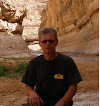Trelew is a small town in Patagonia, founded in 1886, the number of inhabitants is 100 000

The restored railway station building.
And all the guidebooks suggest to pay a visit to The Paleontological Museum of a very good exhibition in Trelew.




A fossilized egg of a dinosaur (Supposed to be an original). Local staff explained that all the items that are behind glass and one cannot touch them - are the originals and everything that is in the open – either specimen in the scale of 1:1, or any other - are copies. And unfortunately the huge skeletons are not originals. Anyway the exhibition was very plentiful and for those more interested - the museum's home page is - www.mef.org

The weather is warm, it is more than +30 degrees and during the mid-day the city is almost deserted.

The next very interesting place – Punta Tomba Penguin Colony - is about 115 km southwards from Trelew. Among the 63 Patagonian Penguin Colonies in Argentina (Spheniscus magellanicus, Penguin magellanicus) - this is the largest. From September to April the 3 kilometre coast is home for more than half a million penguins.
The Patagonian penguin is about 45 cm tall, and the average weight is about 5 kg and they should be living up to the age of 30. The penguins arrive from Brazil in September, first males and a few days later - females. In October the mother-penguin lays two eggs and in November- the first gray penguin chicks will hatch. They are taken care of by both parents. About twenty miles along a dusty gravel road, and that's the right place.

Bare and windy.

There is an exposition introducing the life of the penguins at the visitor`s centre and from here further on to visit the colony is possibly only by small local buses that depart about every twenty minutes.
There is a final briefing - penguins should not be touched or disturbed in any way, and one should not move very close to them.

And one can move on only along marked trails.









More 260 meters, and cannot get any further, because it could be said that the whole earth is covered with penguins.

The nesting area. The ground is perforated like Swiss cheese, and so nearly up to the horizon in all three directions.


The images are gray, of course, again, as the earth was gray and so was the sky, and the sun was not seen anywhere. Even there was no hope of any sunshine at all.


Some guanacos are moving around between the penguins.

Further on along Ruta 3 Road up to a larger town Comodoro Rivadavia, and the next day towards inland. Because there are about 65 million year old fossilized tree stumps near Sarmiento.

The beautiful Patagonian landscape.
Just invites to take photos Outside there is a strong Patagonian wind, and then, while coming out of the car, the strong wind hits the driver`s door almost inside out. The door could somehow be more or less shut but the gap between the door and the jamb is about a centimetre wide. I'm not going to make any repairs at the spot as one must be careful not to be carried away by the wind.

In this area oil is being extracted and there are quite a many unmarked gravel roads in the area. Some of which are freely passable and some not.

"Jose Bosque Petrificado Orimachea" is the official name of the tourist attraction.
There is also a possibility to see a short film about the formation of the petrified forests. The guards recommend to move along the marked route, here you can move around without a guide and it is emphasized that nothing should be taken with from here. And while leaving the place one must show the content of the pockets. And so it was.

Either looking from far or close – it seems to be a real tree, even the circles of the year are appearent, but actually the 65 million years old tree has turned into a stone..


Meanwhile the sun appears from between the clouds and the surroundings become more colourful. The wind was so strong that the path over the hill was not recommended to be used.



The gas station of a small town named Perito Moreno.
While driving in this area it is recommended to fill the car tank at every opportunity, as there could be shortage at the next station. Actually - diesel has been available everywhere and the more southwards – the cheaper. It was interesting to compare the fuel consumption – usually it took 9-10 litres per hundred kilometres, but here against the strong wind and rain in some places even about 15 litres were used, and the speed was about 30-50 miles per hour.




No comments:
Post a Comment